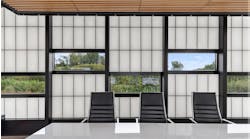More schools and universities are designing their learning spaces to take advantage of daylight, but they still need electric lights to provide illumination when the sun doesn't.
As education institutions determine what kind of electric lighting is needed in their facilities, “the principal objective … is to turn off as many electric lights as possible,” according to the Collaborative for High Performance Schools Best Practices Manual. That means having the ability to adjust the electric lights to complement the available daylight.
Lighting conditions may change frequently depending on the time of day, time of year or weather conditions, so the best way to control lighting conditions in a school is with controls such as timers, sensors and dimmers.
Here are some of the most commonly used lighting controls:
-
Manual switches enable people to turn off lights when daylight is adequate. They also should be installed in spaces with occupancy sensors, the manual says, so people in the space can turn off unneeded lights.
-
Occupancy sensors use motion detectors to turn off lights when spaces are unoccupied. The manual says occupancy sensors are most effective in “spaces that are intermittently occupied or where the lights are likely to be left on” (e.g., classrooms, private offices, restrooms, storage areas). Spaces controlled with occupancy sensors also should have manual override (for video presentations or other situations when the lights need to be turned off).
-
Motion sensors must be adjusted to ensure that they sense motion only in the controlled space, the manual cautions. Motion in adjoining spaces can cause false triggering or cause the lights to remain on needlessly. Conversely, sensors must not turn off lights when spaces are occupied. An additional adjustment to the sensors can control the time-delay period between last detection and lights off.
-
Time controls use preprogrammed scheduling to reduce how long a lighting system is on. “Time controls make sense in applications where the occupancy hours are predictable and where occupancy-sensor automatic control is either impractical or undesirable,” the manual says.
-
Photosensor systems detect the daylight level in a space and send a signal to dim or switch off electric lights. An open-loop system detects only the daylight, and a closed-loop system detects both daylight and electric illumination.
Photosensors must be calibrated to regulate the electric lighting appropriately to maintain the desired levels. Photosensors for open-loop systems must be mounted so they cannot detect the lights they control. Photosensors should not be obstructed by building components or furniture.
For most applications in a school facility, the full-length fluorescent tube is the best choice. “They offer long life, high efficacy, good color and low operating and maintenance costs,” the manual says.
To dim fluorescent lights, special ballasts are required that add to equipment costs. Manufacturers recommend that fluorescent lamps be fully seasoned prior to being dimmed. Dimming the lamps without this “burn-in” period can result in unstable light output or shorter lamp life. Recommendations vary from 10 to 100 hours depending on the manufacturer.
NOTABLE
10
Recommended number of minutes between the last motion detected in a space and when lights are turned off.
Source: Collaborative for High Performance Schools, Best Practices Manual, 2006

